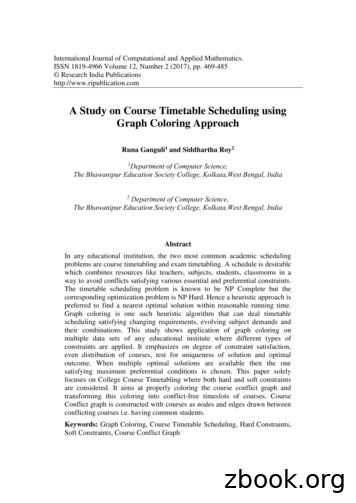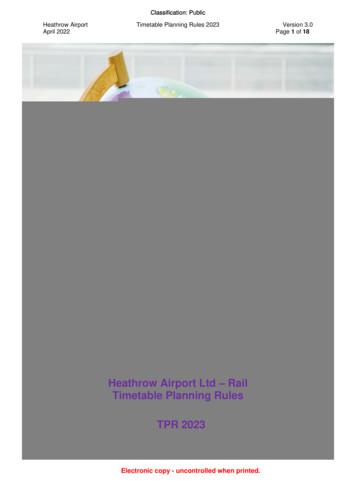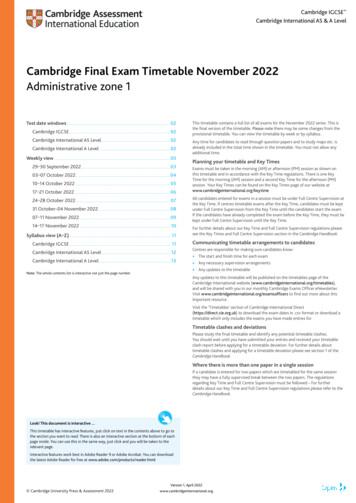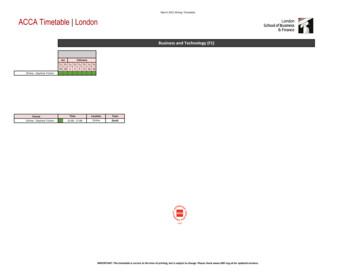A Study On Course Timetable Scheduling Using Graph .
International Journal of Computational and Applied Mathematics.ISSN 1819-4966 Volume 12, Number 2 (2017), pp. 469-485 Research India Publicationshttp://www.ripublication.comA Study on Course Timetable Scheduling usingGraph Coloring ApproachRuna Ganguli1 and Siddhartha Roy21Department of Computer Science,The Bhawanipur Education Society College, Kolkata,West Bengal, India2Department of Computer Science,The Bhawanipur Education Society College, Kolkata,West Bengal, IndiaAbstractIn any educational institution, the two most common academic schedulingproblems are course timetabling and exam timetabling. A schedule is desirablewhich combines resources like teachers, subjects, students, classrooms in away to avoid conflicts satisfying various essential and preferential constraints.The timetable scheduling problem is known to be NP Complete but thecorresponding optimization problem is NP Hard. Hence a heuristic approach ispreferred to find a nearest optimal solution within reasonable running time.Graph coloring is one such heuristic algorithm that can deal timetablescheduling satisfying changing requirements, evolving subject demands andtheir combinations. This study shows application of graph coloring onmultiple data sets of any educational institute where different types ofconstraints are applied. It emphasizes on degree of constraint satisfaction,even distribution of courses, test for uniqueness of solution and optimaloutcome. When multiple optimal solutions are available then the onesatisfying maximum preferential conditions is chosen. This paper solelyfocuses on College Course Timetabling where both hard and soft constraintsare considered. It aims at properly coloring the course conflict graph andtransforming this coloring into conflict-free timeslots of courses. CourseConflict graph is constructed with courses as nodes and edges drawn betweenconflicting courses i.e. having common students.Keywords: Graph Coloring, Course Timetable Scheduling, Hard Constraints,Soft Constraints, Course Conflict Graph
470Runa Ganguli and Siddhartha Roy1. INTRODUCTIONIn the year 1736, graph theory originated from the Konigsberg bridge problempointed out by mathematician Euler which later led to the concept of Eulerian graph[4]. In the same decade, Gustav Kirchhoff established the concept of a tree, aconnected graph without cycles which was used in the calculation of currents inelectrical networks or circuits and later to enumerate chemical molecules. In 1840,A.F Mobius came up with the idea of complete graph and bipartite graph (section1.1). In 1852, Thomas Gutherie found the famous four-color problem. The first resultsabout graph coloring deal exclusively with planar graphs in the form of the coloringof maps [3]. Even though the four-color problem was invented it was solved onlyafter a century by Kenneth Appel and Wolfgang Haken [1]. In 1890, Heawood provedthe five-color theorem, saying that every planar map can be colored with no morethan five colors [2]. In 1912, George David Birkhoff to study coloring problems inalgebraic graph theory introduced the chromatic polynomial [4][5]. Graph Coloringhas many real-time applications including map coloring, scheduling problem, parallelcomputation, network design, sudoku, register allocation, bipartite graph detection,etc [3][4]. Graph coloring has considerable application to a large variety of complexproblems involving optimization [11] In particular, conflict resolution, or the optimalpartitioning of mutually exclusive events, can often be accomplished by means ofgraph coloring. Examples of such problems include course or examination timetablescheduling [6][13][14].While constructing schedule of courses at a college or university, it is obvious thatcourses taught by the same professor and courses that require same classroom must bescheduled at different time slots. Furthermore, a particular student or group ofstudents may be required by a curriculum to take two different but related courses(e.g., physics and Mathematics) concurrently during a semester. In such cases too,courses need to be scheduled in a way to avoid conflicts. Thus, the problem ofdetermining minimum or reasonable number of time slots that can successfullyschedule all the courses subject to restrictions is a typical graph coloring problem[14][16][17]. This paper is concerned with the problem of course timetablescheduling, where graph coloring can provide an algorithm [9] which will prevent orat least minimize conflicting schedules. Thus, optimal solutions to such problems maybe found by determining minimal colorings for the corresponding graphs.Unfortunately, this may not always be accomplished in polynomial time. As the graphcoloring problem is known to be NP-complete [4][12] there is no known algorithmwhich, for every graph, will optimally color the nodes of the graph in a time boundedby a polynomial in the number of nodes. Many graph coloring algorithm such as theSaturation algorithm, the Recursive Largest First algorithm, Simulated Annealingalgorithm, Greedy algorithm, are NP complete [4][12].
A Study on Course Timetable Scheduling using Graph Coloring Approach4711.1 Basic Concepts of Graph Theory:A graph G is an ordered triplet (V(G), E(G), ф) consisting of a non-empty set V ofvertices or nodes, E is the set of edges and ф is the mapping from the set of edges Eand the set of vertices V.In a bipartite graph (or bigraph) (Fig. 1) the set of vertices V can be partitioned intotwo disjoint sets V1 and V2 such that every edge of the graph connects a vertex in V1to one in V2, i.e. V1 and V2 are independent sets.V1V2Fig. 1 Bipartite graphGiven a graph G, a vertex coloring of G (Fig. 2(a)) is a function f: VC where V isa set of vertices of the graph G and C is the set of colors. It is often both conventionaland convenient to use numbers 1, 2, .n for the colors. Proper k-coloring [4][5] of Gis a coloring function f which uses exactly k colors and satisfies the property that f(x) f(y) whenever x and y are adjacent in G.The smallest number of colors needed to color G is known as it's chromatic numberX(G)[4][5]. A graph that can be assigned a proper k-coloring is called k-colorable,and it is k-chromatic if it’s chromatic number is exactly k. The chromatic polynomialcounts the number of ways a graph can be colored using no more than a given numberof colors.Edge-coloring of graphs (Fig. 2(b)) is similar to vertex-coloring. Given a graph G, anedge-coloring of G is a function f0 from the edges of G to a set C of elements calledcolors.Fig. 2(a) Vertex Coloring2(b) Edge Coloring
472Runa Ganguli and Siddhartha RoyWe have studied that for every edge coloring problem there exists an equivalentvertex coloring problem [4] of its line graph. Given a graph G, its line graph L(G) is agraph such that each vertex of L(G) represents an edge of G, vertices of L(G) areadjacent if and only if their corresponding edges share a common endpoint (areincident) in G. The line graph L(G) of a given graph G is a simple graph whoseproper vertex coloring gives a proper edge coloring of G by the same number ofcolors.After discussing the introductory concept of graph theory related to graph coloringproblem, in the above subsection 1.1, we present the literature survey in section 2,which describes various research works that have been done on scheduling problemsusing graph coloring method. The concept of scheduling problems in general alongwith various constraints involved and special emphasize on Course Timetablescheduling are mentioned in Section 3. Next Section 4 covers the workingmethodology and the corresponding algorithm used. Two cases of course timetablescheduling problems (Honours/Major-General/Minor Subject combination andTeacher-Subject Combination) of undergraduate courses under Indian Universitieshave been studied and corresponding solutions proposed. This paper ends in section 6with some concluding remarks.2. LITERATURE SURVEYSolving timetabling problems through application of computers has a long and variedhistory. In 1967, the problem of course scheduling was applied to graph coloring[6][13][17][18]. In 1967 Welsh and Powell [10] illustrating the relationship betweentimetabling and graph coloring, and developed a new general graph coloringalgorithm to solve (or approximately solve) the minimum coloring problem moreefficiently. They were also successful in coloring graphs that arise from timetablingproblems, more specifically examination timetabling problems. In 1969, Wood’sgraph algorithm [14] operated on two n n matrices, where n denotes the number ofvertices in the graph; a conflict matrix C was used to illustrate which pairs of verticesmust be colored differently due to constraint restrictions in the problem and asimilarity matrix S was used to determine which pairs of vertices should be coloredthe same. Dutton and Bingham in 1981 introduced two of the most popular heuristicgraph coloring algorithms. Considering each color one by one, a clique [4] is formedby continually merging the two vertices with the most common adjacent vertices. Oncompletion, identical coloring is applied to all the vertices which are merged into thesame.In 1986, Carter [19] in his examination timetabling survey refers to some of theabove-mentioned graph coloring algorithms and heuristics and shows how graphtheoretic approach to timetable scheduling is one of the most popular. It has beenaccepted and applied by many educational institutions to solve their examinationtimetabling problems. According to Carter in his survey, work of Mehta is significantas its objective of obtaining “conflict-free” schedules, given a fixed number of timeperiods turned out to be one of the most complex timetabling applications [15]. In
A Study on Course Timetable Scheduling using Graph Coloring Approach4731991, Johnson, Aragon, McGeoch and Schevon [20] implemented and tested threedifferent approaches for graph coloring with a simulated annealing technique,observing that simulated annealing algorithms can achieve good results, but only ifallowed a sufficiently large run time. In 1992, Kiaer and Yellen in a paper [21]describes a heuristic algorithm using graph coloring approach to find approximatesolutions for a university course timetabling problem. The algorithm using a weightedgraph to model the problem aimed at finding a least cost k-coloring of the graph (kbeing number of available timeslots) while minimizing conflicts. In 1994, Burke,Elliman and Weare [22] introduced plans for a university timetabling system based ongraph coloring and constraint manipulation. Graph coloring and room allocationheuristic algorithms were described along with an illustration of how the two can becombined to provide the basis of a system for timetabling. The authors also discussedthe handling of several common timetabling features within the system, primarilywith regards to examination timetabling. In 1995, graph coloring method wasintroduced aiming at optimizing solutions to the timetable scheduling problems [11].Bresina (1996) was among the early researchers who used this approach and madeseveral modifications in the manual approach conducted at universities [23]. In 2007,for university timetabling an alternative graph coloring method was presented thatincorporates room assignment during the coloring process [6]. In 2008, the Koalagraph coloring library was developed which includes many practical applications ofgraph coloring, and is based on C [7]. In 2009, automata-based approximationalgorithms were proposed for solving the minimum vertex coloring problem [8]. A.Akbulut and G. Yılmaz in 2013[24] proposed a new university examinationscheduling system using graph coloring algorithm based on RFID technology. Thiswas examined by using different artificial intelligence approaches. Also, in recentyear researchers have been exploring new alternative methods to deal schedulingproblems for obtaining better result.3. SCHEDULING PROBLEMThe general idea of a scheduling problem is defined by allocation of related resourcesamong a number of time-slots satisfying various types of essential and preferentialconstraints aiming at creating optimized conflict-free schedule.Some of the typical scheduling problems include Timetable Schedulinga.Course Timetable Scheduling- courses sharing common resources to bescheduled in conflict-free time-slots.b.Exam Timetable Scheduling – exams sharing common resources to bescheduled in conflict-free time-slots. Aircraft Scheduling- aircrafts need to be assigned to flights.
474Runa Ganguli and Siddhartha Roy Job Shop Scheduling- for a given set of jobs with their processing times and agiven set of machines, a schedule mapping jobs to machines meeting feasibilityconstraints and optimization objectives.3.1 Motivation towards Timetable SchedulingEffective timetable is vital to the performance of any educational institute. It impactstheir ability to meet changing and evolving subject demands and their combinations ina cost-effective manner satisfying various constraints. In this paper, we have focusedour work into Course Timetable Scheduling.3.2 Course Timetable SchedulingCourse Timetabling is the scheduling of a set of related courses in a minimal numberof time-slots such that no resource is required simultaneously by more than one event.In a typical educational institute resources, which may be required by coursessimultaneously can be students, classrooms and teachers.3.3 ConstraintsConstraints are the most vital aspect of any scheduling problem. These are the variousrestrictions involved in creating a schedule. Based on satisfaction of these a schedulecan be accepted or get rejected. Depending on the degree of strictness, constraints arebroadly classified into- Hard and Soft Constraints [11].3.3.1 Hard and Soft ConstraintsHard Constraints are those essential conditions which must be satisfied to have a legalschedule. If any of the hard constraints cannot be placed successfully by a schedule,then such a schedule is rejected. For example, no two subjects having commonstudents can be scheduled in the same time-slot, courses cannot be assigned to morethan maximum number of available time-slots or periods. In those scheduling datasetswhich involve resources like teachers and classrooms, no courses can be scheduled tothe same classroom at same time-slot, more than one course taught by the sameteacher cannot be assigned same time of the week.Soft Constraints on the other hand are those preferential conditions which areoptional. Mostly, it gets difficult to incorporate all the soft constraints in a schedule. Aschedule is still said to be legal even if it fails to satisfy soft constraints, provided allhard constraints are met. For example- a teacher may prefer to take practical classesonly in the second half, honours and pass classes are preferred to be scheduled in nonoverlapping time-slots, etc.
A Study on Course Timetable Scheduling using Graph Coloring Approach4753.3.2 Temporal and Spatial ConstraintsConstraints can also be viewed as time-related and space-related conditions. Timerelated constraints are called Temporal constraints. For example, Computer Sciencetheory and practical classes cannot be scheduled at the same time-slot or periodbecause of common students. Also, there must be a fixed number of theory andpractical classes scheduled in a week.On the other hand, space-related constraints are called Spatial constraints. In coursescheduling problem, spatial constraints mainly involve classroom related issues. Anyeducational institute has a fixed number of available rooms with specified capacity.Also, classrooms can be theory or laboratory based. While making schedules, courseshaving student capacity compatible to the classroom size is an essential condition.Courses which need specific classroom type need to be assigned accordingly.Both temporal and spatial constraints are mainly hard type constraints whosefulfilment determines the effectiveness of a schedule.4. METHODOLOGYFor solving Course Timetable scheduling problems using graph coloring, the problemis first formulated in the form of a graph where courses act as vertices. Depending ontype of graph created, edges are drawn accordingly. One type is conflicting graphwhere edges are drawn between conflicting courses having common students. Otherone is non-conflicting graph, where edges are drawn between mutually exclusivecourses having no students in common. Sometimes it is found that creating a nonconflicting graph from the given input set and constraints is easier costing less time.This non-conflicting graph needs to be complemented to obtain the required conflictgraph whose proper coloring provides the desired solution. This two-step method isefficient in certain cases, while in some conflict graph is created directly.Some problems involve few resources while others may require many at a time.Courses can also conflict due to common teachers, common classrooms in addition tocommon students. In such cases, the conflict graph must consider course, teacher androom conflicts simultaneously.As mentioned earlier, there can be various aspects of a scheduling problem. Whenteachers are involved in resources, other factors like availability of teachers, subjectarea preferred by each teacher acts as additional data inputs which needs to beprovided for making a complete schedule.4.1.Graph Coloring Algorithm:Input: The course conflict graph G thus obtained act as the input of graph coloringalgorithm.Output: The minimum number n of non-conflicting time-slots required to schedulecourses.
Runa Ganguli and Siddhartha Roy476Degree sequence is the array having degree of each vertices of the input graph G.Colors being used are stored in Used Color array. And the chromatic number will bethe total number of elements in the Used Color array.Step 1: Input the conflict graph G.Step 2: Compute degree sequence of the input conflict graph G.Step 3: Assign color1 to the vertex vi of G having highest degree.Step 4: Assign color1 to all the non-adjacent uncoloured vertices of vi and storecolor1 into Used Color array.Step 5: Assign new color which is not previously used to the next uncoloured vertexhaving next highest degree.Step 6: Assign the same new color to all non-adjacent uncoloured vertices of thenewly colored vertex.Step 7: Repeat step-5 and step-6 until all vertices are colored.Step 8: Set minimum number of non-conflicting time-slots n chromatic number ofthe colored graph total number of elements in Used Color array.Step 9: End5.CASE STUDIESUndergraduate colleges under Indian Universities offer a variety of subjectcombinations to its students. In streams like B.A or B.Sc., students can take onesubject as Honours (Major) and two subjects as General (Minor/Pass) papers. Also, toconduct such courses teachers of respective subjects are needed to be scheduledaccording to their availabilities in minimum number of time slots without anyconflict. In the following subsection, we have presented two such typical cases ofscheduling problems and their conflict free solution timetables.5.1 Example 1: Honours and General subject combinationProblem Definition:Suppose in any College of undergraduate science students, given n number of honourssubjects and m number of general subjects, the available number of p periods coursetimetable should be prepared satisfying some given constraints. The objective is tofind minimum number of time slots to schedule all the courses without conflict.
A Study on Course Timetable Scheduling using Graph Coloring Approach477Input Dataset: Table 1 shows the Honours-General subject combination of a typicalundergraduate science course.Table 1 Honours-General Subject CombinationSl.No.List of HonoursSubjectsGeneral Subject CombinationMathematics(compulsory) Physics1Computer y) Chemistry2Physics/Computer SciencePhysics(compulsory) Mathematics3Chemistry/Computer
1.1 Basic Concepts of Graph Theory: A graph G is an ordered triplet (V(G), E(G), ф) consisting of a non-empty set V of vertices or nodes, E is the set of edges and ф is the mapping from the set of edges E and the set of vertices V. In a bipartite graph (or bigraph) (Fig. 1) the set of vertices V can be partitioned into
Timetable Planning Rules. Final Timetable Planning Rules are issued with timetable Access Request information before the commencement of the development period for the Principal Change timetable to which the Rules apply and cover a 12-month period. Revised Timetable Planning Rules are issued with timetable Access Request information
Cambridge IGCSE . This timetable contains a full list of all exams for the November 2022 series. This is the final version of the timetable. Please note there may be some changes from the provisional timetable. You can view the timetable by week or by syllabus. Any time for candidates to read through question papers and to study maps etc. is
The Timetable works on calendar weeks with week 1 commencing 28 December 2015. There are 11 Study Periods included in the timetable, each with a different week numbering system. Study Period week numbering can be converted to Timetable Calendar weeks using the table below. For example, Study Period 1 (SP1) week 1 corresponds to Calendar Week 9 .
ACCA Timetable London Tu Th Tu Th Tu Th Tu Th 26 28 2 4 9 11 16 18 Online - Daytime Tuition Course Online - Daytime Tuition Business and Technology (F1) Jan February Location Tutor 15:00 - 17:00 Online David Time IMPORTANT: This timetable is correct at the time of printing, but is subjec
View your Class Schedule Once you have logged into My Class Timetable, you will see a screen similar to the example show below. Top section (Timetable Search) Here you can use the Unit for and Week Starting search criteria to filter the timetable information displayed (see image below).
EXAMINATION BOOKLET SUMMER 2017 Name: Tamika Adamson Candidate Number: 6002 Centre Number: 13348 This booklet contains the examination timetable for the Summer 2017 examination series along with the JCQ Exam Regulations which you must abide by. Please check through the timetable and use it alongside your Individual Candidate Timetable and
CAPACITY PLANNING PRODUCTION SCHEDULE CALENDAR OF MILESTONE DATES 1. December 2021 Timetable 2. May 2022 Timetable Published on behalf of: Network Rail Capacity Planning Network Rail Quadrant: MK Elder Gate Milton Keynes Central MK9 1EN Issue Date: July 2020 Version No’: 1.1 (last updated Nov 2020) Matt Allen Head of Timetable Production
2.2.7 Confirm the Stage 2 timetable for services and note its relationship to the project timetable as agreed with the client. The timetable should show critical points by which information from the client and design team members will be required. Enter notes here Completed on 2.2.8 Co























